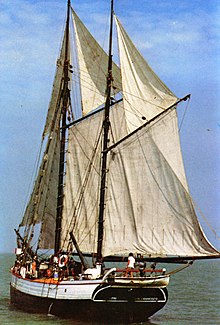Fernando Pereira was a Portuguese-Dutch freelance photographer, who drowned when French intelligence (DGSE) detonated a bomb and sank the Rainbow Warrior, owned by the environmental organisation Greenpeace on 10 July 1985.
The Committee for Non-Violent Action (CNVA) was an American anti-war group, formed in 1957 to resist the US government's program of nuclear weapons testing. It was one of the first organizations to employ nonviolent direct action to protest against the nuclear arms race.
Albert Smith Bigelow was a pacifist and former United States Navy Commander, who came to prominence in the 1950s as the skipper of the Golden Rule, the first vessel to attempt disruption of a nuclear test in protest against nuclear weapons.
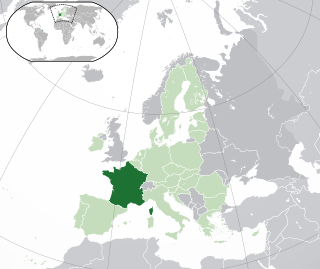
France is one of the five "Nuclear Weapons States" under the Treaty on the Non-Proliferation of Nuclear Weapons, but is not known to possess or develop any chemical or biological weapons. France is the only member of the European Union to possess independent (non-NATO) nuclear weapons. France was the fourth country to test an independently developed nuclear weapon, doing so in 1960 under the government of Charles de Gaulle. The French military is currently thought to retain a weapons stockpile of around 300 operational (deployed) nuclear warheads, making it the third-largest in the world, speaking in terms of warheads, not megatons. The weapons are part of the national Force de frappe, developed in the late 1950s and 1960s to give France the ability to distance itself from NATO while having a means of nuclear deterrence under sovereign control.

Moruroa, also historically known as Aopuni, is an atoll which forms part of the Tuamotu Archipelago in French Polynesia in the southern Pacific Ocean. It is located about 1,250 kilometres (780 mi) southeast of Tahiti. Administratively Moruroa Atoll is part of the commune of Tureia, which includes the atolls of Tureia, Fangataufa, Tematangi and Vanavana. France undertook nuclear weapon tests between 1966 and 1996 at Moruroa and Fangataufa, causing international protests, notably in 1974 and 1995. The number of tests performed on Moruroa has been variously reported as 175 and 181.

Fangataufa is an uninhabited coral atoll in the eastern part of the Tuamotu Archipelago in French Polynesia. The atoll has been fully-owned by the French state since 1964. From 1966 to 1996 it was used as a nuclear test site by the French government. In total, 4 atmospheric and 10 underground nuclear explosions were carried out on the atoll.
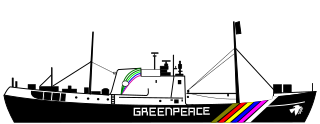
The sinking of Rainbow Warrior, codenamed Opération Satanique, was a state terrorism bombing operation by the "action" branch of the French foreign intelligence agency, the Directorate-General for External Security (DGSE), carried out on 10 July 1985. During the operation, two operatives sank the flagship of the Greenpeace fleet, Rainbow Warrior, at the Port of Auckland on her way to a protest against a planned French nuclear test in Moruroa. Fernando Pereira, a photographer, drowned on the sinking ship.
The Don't Make a Wave Committee was the name of the anti-nuclear organization which later evolved into Greenpeace, a global environmental organization. The Don't Make a Wave Committee was founded in Vancouver, British Columbia, Canada to protest and attempt to halt further underground nuclear testing by the United States in the National Wildlife Refuge at Amchitka in the Aleutian Islands of Alaska. The Don't Make a Wave Committee was first formed in October 1969 and officially established in early 1970.
Greenpeace Aotearoa (GPAo) is one of New Zealand's largest environmental organisations, and is a national office of the global environmental organisation Greenpeace.
Peter Willcox is an American sea captain best known for his activism with the environmental organization Greenpeace. He was on board as captain of the Rainbow Warrior when it was bombed and sunk by the DGSE in New Zealand in 1985.

HMNZS Otago (F111) was a Rothesay-class frigate acquired from the United Kingdom by the Royal New Zealand Navy (RNZN) before completion.

Campaign for Nuclear Disarmament (NZ) was co-founded in Christchurch, New Zealand in 1959 with the help of Elsie Locke and Mary Woodward. Mabel Hetherington, who belonged to an earlier generation of peace activists from England, was largely responsible for setting up the organization in Auckland when she moved to New Zealand after World War II. With Alison Duff and Pat Denby, Hetherington carried it in Auckland through the 1960s. It was largely from the Campaign for Nuclear Disarmament (NZ) and the Peace Media that Greenpeace New Zealand evolved.
In 1984, Prime Minister David Lange banned nuclear-powered or nuclear-armed ships from using New Zealand ports or entering New Zealand waters. Under the New Zealand Nuclear Free Zone, Disarmament, and Arms Control Act 1987, territorial sea, land and airspace of New Zealand became nuclear-free zones. This has since remained a part of New Zealand's foreign policy.
Greenpeace Foundation is an environmental organization based in Hawaii. It was officially founded in 1976 as an independent offshoot of the Canadian Greenpeace Foundation and was the first Greenpeace in the United States. When the original Vancouver-based Greenpeace Foundation later evolved to Greenpeace International the Hawaii-based Greenpeace Foundation declined to join them, and remains an unaffiliated organisation.
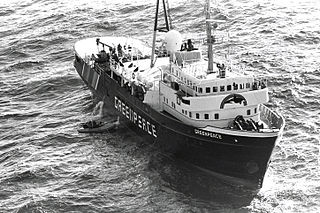
The MV Greenpeace was a Greenpeace ship built in 1959 as an oceangoing tug/salvage vessel. She was purchased by Greenpeace in 1985 from the Maryland Pilotage Company, the vessel then being named MV Maryland, and transferred back to the Netherlands to be refitted with modern equipment before being recommissioned. She took over from the first Rainbow Warrior, which had been sunk in 1985 by French commandos. In 2001 she was replaced by the MV Esperanza.

Rainbow Warrior was a Greenpeace ship involved in campaigns against whaling, seal hunting, nuclear testing and nuclear waste dumping during the late 1970s and early 1980s. The Direction Générale de la Sécurité Extérieure bombed Rainbow Warrior in the Port of Auckland, New Zealand on 10 July 1985, sinking the ship and killing photographer Fernando Pereira.

Anti-nuclear protests began on a small scale in the U.S. as early as 1946 in response to Operation Crossroads. Large scale anti-nuclear protests first emerged in the mid-1950s in Japan in the wake of the March 1954 Lucky Dragon Incident. August 1955 saw the first meeting of the World Conference against Atomic and Hydrogen Bombs, which had around 3,000 participants from Japan and other nations. Protests began in Britain in the late 1950s and early 1960s. In the United Kingdom, the first Aldermaston March, organised by the Campaign for Nuclear Disarmament, took place in 1958. In 1961, at the height of the Cold War, about 50,000 women brought together by Women Strike for Peace marched in 60 cities in the United States to demonstrate against nuclear weapons. In 1964, Peace Marches in several Australian capital cities featured "Ban the Bomb" placards.
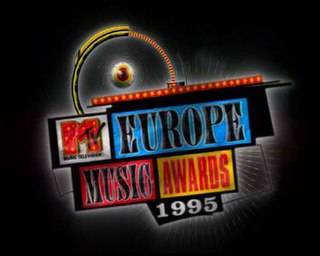
The 1995 MTV Europe Music Awards took place at the Le Zénith in Paris, France and were hosted by Jean-Paul Gaultier.
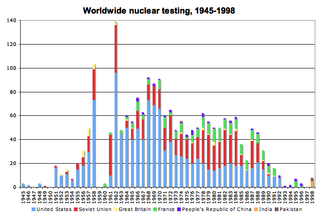
The application of nuclear technology, both as a source of energy and as an instrument of war, has been controversial.
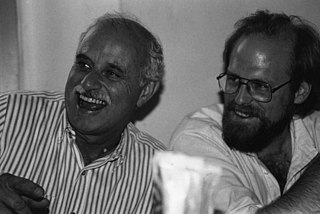
Stephen Gregory Sawyer was an American environmentalist and activist. He served as a leader of Greenpeace for nearly 30 years, including two decades as executive director. While on a mission to stop French nuclear testing in French Polynesia, he survived France's bombing of the Greenpeace boat Rainbow Warrior, which occurred on his 29th birthday.
